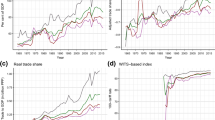Abstract
The removal of the internal frontiers within the EC will tend to have a negative effect on trade relations between EC and CMEA countries. The implications of 1992 for trade patterns between the EC and the CMEA are examined in the following article and the role which future EC trade policy could play here is outlined.
Similar content being viewed by others
References
Paul R. Krugman: Concepts of Economic Integration in Europe, in: Efficiency, Stability and Equity: A Strategy for the Evolution of the Economic System of the European Community. A report by Tommaso Padoa-Schioppa et al., Oxford 1987.
Cf. Susan Strange: A Dissident View, in: Roland Bieber et al.: 1992: One European Market? A Critical Analysis of the Commission’s Internal Market Strategy, Baden-Baden 1988, pp. 73 ff.
Art. 8A, EEC Treaty.
Art. 100A, EEC Treaty.
Ibid. Art. 100A, EEC Treaty.
Ibid., Art. 100A, EEC Treaty. para. 2.
Helmut Schmitt von Sydow, in: Roland Bieber et al., op. cit., 1992: One European Market? A Critical Analysis of the Commission’s Internal Market Strategy, Baden-Baden 1988, p. 102.
Art. 100B. EEC Treaty.
Single Act, Art. 23.
Doc COM (87) 100.
John Pinder: Enhancing the Community’s Economic and Political Capacity: Some Consequences of Completing the Common Market, in: Roland Bieber et al. op. cit., 1992: One European Market? A Critical Analysis of the Commission’s Internal Market Strategy, Baden-Baden 1988, pp. 35 ff.; Paul R. Krugman, op. cit., Concepts of Economic Integration in Europe, in: Efficiency, Stability and Equity: A Strategy for the Evolution of the Economic System of the European Community. A report by Tommaso Padoa-Schioppa et al., Oxford 1987; Paolo Cecchini: The Economics of 1992, in: European Economy, No. 35, March 1988.
Paolo Cecchini, op. cit., The Economics of 1992, in: European Economy, No. 35, March 1988. p. 117.
Ibid., Paolo Cecchini, op. cit., The Economics of 1992, in: European Economy, No. 35, March 1988. pp. 133 f.
Ibid., Paolo Cecchini, op. cit., The Economics of 1992, in: European Economy, No. 35, March 1988, p. 29.
Ibid., Paolo Cecchini, op. cit., The Economics of 1992, in: European Economy, No. 35, March 1988, p. 19.
Ibid., Paolo Cecchini, op. cit., The Economics of 1992, in: European Economy, No. 35, March 1988. p. 130.
John Pinder, op. cit., Enhancing the Community’s Economic and Political Capacity: Some Consequences of Completing the Common Market, in: Roland Bieber et al. op. cit., 1992: One European Market? A Critical Analysis of the Commission’s Internal Market Strategy, Baden-Baden 1988. p. 50.
Wjociech Kostrzewa: Verpaßt Osteuropa den Anschluß auf den Weltmärkten?, in: Kieler Diskussionsbeiträge, No. 144, September 1988.
Stanisiaw Gomulka: Reasons for Shifts in Competitiveness in Western und Eastern Countries, paper prepared for the Malente Symposium VIII “On the Way to stronger East-West Economic Relations: Chances and Challenges”, October 1989.
Paolo Cecchini, op. cit., The Economics of 1992, in: European Economy, No. 35, March 1988. p. 140.
Author information
Authors and Affiliations
Additional information
This article is a revised version of a lecture given at the sixteenth annual EARIE conference, August 30th–September 1st, 1989, in Budapest.
Rights and permissions
About this article
Cite this article
Tomann, H. EC internal market: An opportunity for CMEA countries?. Intereconomics 24, 303–308 (1989). https://doi.org/10.1007/BF02924739
Issue Date:
DOI: https://doi.org/10.1007/BF02924739




